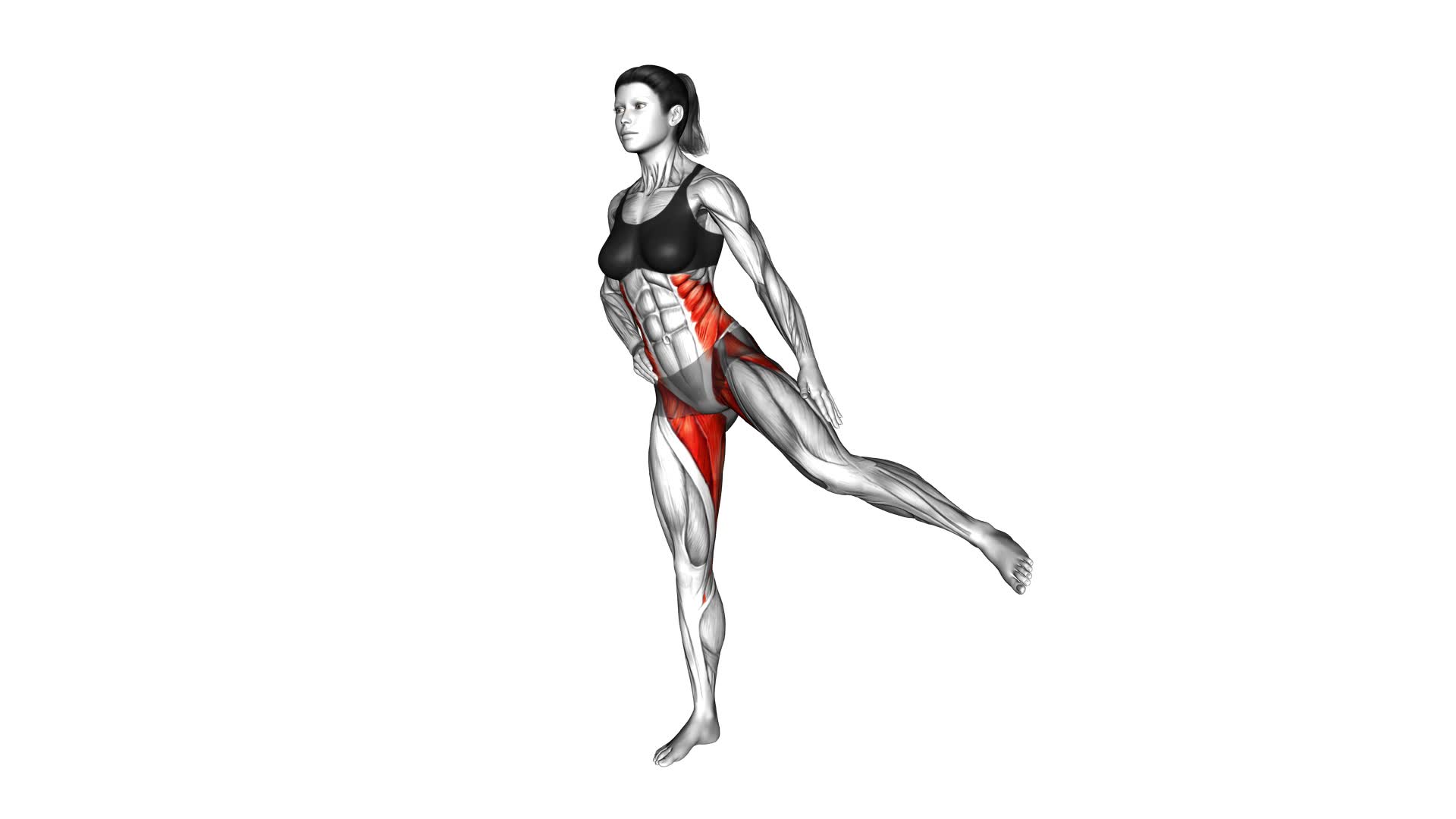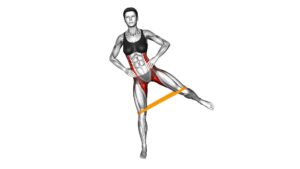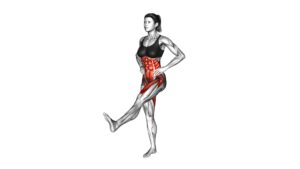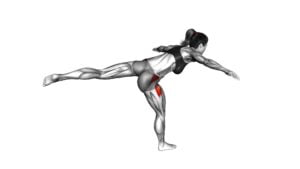Standing Balance Hip Abduction (female) – Video Exercise Guide & Tips

Get ready to strengthen and tone your hip muscles with standing balance hip abduction.
Watch This Exercise Video
In this video exercise guide, we'll show you the proper technique and provide helpful tips to maximize the effectiveness of this exercise.
Whether you're a beginner or more advanced, modifications are available for all fitness levels.
Avoid common mistakes and ensure your safety with our expert advice.
Let's dive in and start working those hips!
Key Takeaways
- Standing balance hip abduction increases strength and stability in the hips.
- It targets the gluteus medius and minimus muscles.
- This exercise improves balance, stability, and overall hip function.
- It helps prevent and alleviate hip pain and discomfort.
Benefits of Standing Balance Hip Abduction
You will experience increased strength and stability in your hips through the practice of standing balance hip abduction. This exercise specifically targets the muscles in your hips, including the gluteus medius and minimus. By performing standing balance hip abduction, you can improve your balance, stability, and overall hip function.
To ensure proper form and technique, it's important to understand the modifications that can be made for standing balance hip abduction. If you're a beginner or have limited hip mobility, you can start by performing the exercise near a wall or using a chair for support. This will help you maintain balance as you lift one leg to the side.
When performing standing balance hip abduction, it's crucial to engage your core muscles and maintain a tall posture throughout the exercise. Begin by standing with your feet hip-width apart and slowly lift one leg out to the side, keeping your toes pointing forward. Hold this position for a few seconds before returning to the starting position. Repeat on the other side.
Proper Technique for Standing Balance Hip Abduction
Now let's dive into the proper technique for standing balance hip abduction.
It's important to be aware of common mistakes to avoid, as well as the benefits of hip abduction.
Common Mistakes to Avoid
What are some common mistakes to avoid while performing standing balance hip abduction?
To ensure proper form and maximize the effectiveness of this exercise, it's important to be aware of potential errors.
One common mistake is leaning too far forward or backward during the movement. This can compromise your balance and stability, reducing the effectiveness of the exercise. To avoid this, focus on maintaining an upright posture throughout the entire movement.
Another mistake to watch out for is lifting the leg too high or too quickly. This can lead to a loss of control and increase the risk of injury. Instead, aim for controlled and gradual movements, focusing on engaging the hip muscles.
Benefits of Hip Abduction
To enhance your balance and strengthen your hip muscles, properly executing the standing balance hip abduction exercise offers numerous benefits.
Hip abduction exercises specifically target the muscles in your hips, such as the gluteus medius and minimus. These exercises help to improve the stability and strength of your hip joint, which can enhance your overall balance and stability.
By strengthening these muscles, you can also improve your ability to perform everyday activities, such as walking and climbing stairs, with greater ease and efficiency.
Additionally, hip abduction exercises can help to prevent and alleviate hip pain and discomfort, as they promote proper alignment and function of the hip joint.
Incorporating these exercises into your fitness routine can provide you with the hip strengthening benefits you need for optimal physical performance.
Modifications for Different Fitness Levels
Now let's talk about modifications for different fitness levels. Whether you're a beginner, intermediate, or advanced, there are ways to tailor the standing balance hip abduction exercise to your specific needs and abilities.
Beginners can start with simpler modifications, while intermediates can progress to more challenging variations.
Advanced individuals can explore advanced variations to further enhance their strength and balance.
Let's explore these modifications and progressions to help you find the right level of challenge for your fitness journey.
Beginner Modifications
You can modify the Standing Balance Hip Abduction exercise to suit your fitness level. Here are four beginner modifications that can help you perform the exercise with proper technique:
- Start with a smaller range of motion: If you find it challenging to lift your leg to the side while maintaining balance, you can reduce the height and focus on stability.
- Use a support: Holding onto a chair or wall can provide additional support and help you maintain your balance throughout the exercise.
- Decrease the duration: Begin by holding the lifted leg for a shorter period of time, gradually increasing the duration as your strength and balance improve.
- Perform the exercise seated: If standing is too challenging, you can perform the hip abduction exercise while seated on a chair to reduce the difficulty level.
Intermediate Progressions
For increased difficulty levels, modify the Standing Balance Hip Abduction exercise by incorporating these intermediate progressions.
These progression variations are designed to challenge your balance and strengthen your hip muscles even further.
One option is to perform the exercise on an unstable surface, such as a balance board or Bosu ball. This will require more stabilization from your core and leg muscles.
Another advanced modification is to add resistance by using ankle weights or a resistance band. This will increase the workload on your hip muscles, making the exercise more challenging.
Remember to maintain proper form throughout the exercise and start with lighter weights or lower resistance bands before progressing to heavier weights or higher resistance.
These advanced modifications will help you take your Standing Balance Hip Abduction exercise to the next level.
Advanced Variations
To further challenge your balance and strengthen your hip muscles, incorporate advanced variations of the Standing Balance Hip Abduction exercise. These advanced progressions provide a greater challenge and help you take your workout to the next level. Here are four advanced modifications to try:
- Single-leg Standing Balance Hip Abduction: Lift one leg off the ground while performing the hip abduction movement. This increases the difficulty by requiring more stability and strength in the standing leg.
- Resistance Band Standing Balance Hip Abduction: Attach a resistance band around your ankles or thighs to add resistance and intensify the exercise. This will engage your hip muscles even more.
- Weighted Standing Balance Hip Abduction: Hold a dumbbell or kettlebell in your hand while performing the exercise. The added weight increases the demand on your hip muscles, making them work harder.
- Bosu Ball Standing Balance Hip Abduction: Perform the exercise on a Bosu ball to challenge your balance and stability even further. This requires more core engagement and coordination.
Incorporating these advanced modifications will help you continue progressing and achieving greater strength and stability in your hips.
Now, let's move on to the next section and discuss common mistakes to avoid.
Common Mistakes to Avoid
Avoid making the mistake of leaning too far forward during the Standing Balance Hip Abduction exercise. Leaning forward can compromise your balance and decrease the effectiveness of the exercise. To maximize its benefits, it's crucial to maintain proper form throughout the movement.
Another common mistake to avoid isn't engaging your core muscles. Your core plays a significant role in stabilizing your body during the exercise. Failing to engage your core can lead to instability and potential injury. Make sure to keep your abdominal muscles tight throughout the movement to enhance your overall balance and control.
Additionally, rushing through the exercise is a mistake that many people make. It's important to perform the Standing Balance Hip Abduction exercise with control and precision. Slow and controlled movements won't only help you maintain balance but also target the intended muscles more effectively.
Lastly, avoid relying too heavily on your supporting leg. While it's natural to rely on the leg that's on the ground, try to distribute your weight evenly between both legs. This will ensure that you're engaging the muscles in both legs and getting a balanced workout.
Tips for Maximizing the Effectiveness of the Exercise
To enhance the effectiveness of the Standing Balance Hip Abduction exercise and maximize your results, focus on maintaining proper form and engaging your core muscles throughout the movement. Here are some tips to help you get the most out of this exercise:
- Keep your body aligned: Stand tall with your feet hip-width apart and your shoulders relaxed. Avoid leaning to one side or arching your back, as this can compromise your balance and reduce the effectiveness of the exercise.
- Control your movements: Slowly lift your leg out to the side, focusing on using your hip muscles to perform the abduction. Avoid swinging your leg or using momentum to complete the movement. This will ensure that you're targeting the right muscles and maximizing the benefits of the exercise.
- Engage your core: Throughout the exercise, actively engage your core muscles by pulling your belly button in towards your spine. This will help stabilize your body and improve your overall balance, leading to better results.
- Progress gradually: As you become more comfortable with the exercise, you can increase the difficulty by adding ankle weights or using a resistance band. This will challenge your muscles and help you continue to maximize your results.
By following these tips and incorporating the Standing Balance Hip Abduction exercise into your regular workout routine, you can strengthen your hip muscles, improve your balance, and maximize your results.
Safety Precautions and Considerations
When considering safety precautions and considerations for the Standing Balance Hip Abduction exercise, it's important to maintain proper form and be mindful of your body's limitations. Fall prevention and injury prevention should be top priorities during this exercise. To ensure a safe and effective workout, follow these guidelines.
First and foremost, make sure you have a stable surface to stand on. Avoid slippery or uneven surfaces that could increase the risk of falls. It's also important to wear appropriate footwear that provides good traction and support.
Maintain proper form throughout the exercise. Stand tall with your feet hip-width apart and engage your core muscles. This will help you maintain balance and stability during the movement. Keep your movements controlled and avoid any jerking or swinging motions that could lead to injury.
Listen to your body and be aware of any discomfort or pain. If you experience any sharp or intense pain, stop the exercise immediately and consult a healthcare professional. It's better to take a break and address any issues than to push through and risk further injury.
Lastly, start with a weight that's appropriate for your fitness level and gradually increase the intensity as you become stronger and more comfortable with the exercise. This will help reduce the risk of straining or overloading your muscles.
Frequently Asked Questions
How Many Repetitions and Sets Should I Do for Standing Balance Hip Abduction?
To determine the number of repetitions and sets for standing balance hip abduction, consider factors like your fitness level and goals. Generally, it's recommended to start with 2-3 sets of 10-15 repetitions.
As you progress, you can gradually increase the number of sets and repetitions. Remember to listen to your body and adjust accordingly.
Consulting with a fitness professional can provide personalized guidance for optimal results.
Can I Perform Standing Balance Hip Abduction if I Have a Knee Injury?
Yes, you can still perform standing balance hip abduction even with a knee injury. However, it's important to modify the exercise to avoid aggravating your knee.
Instead of standing, you can try performing the exercise while seated or lying down. This will reduce the stress on your knee while still targeting the hip muscles.
Additionally, there are alternative exercises you can do to work on hip abduction without putting strain on your knee.
Is It Normal to Feel a Burning Sensation in the Hip Muscles During the Exercise?
Feeling a burning sensation in your hip muscles during exercise can be normal and is often caused by the muscles working hard. This sensation may also be a result of muscle fatigue or lactic acid buildup.
To reduce or manage this burning sensation, try starting with lighter weights or resistance bands and gradually increase the intensity over time. Additionally, make sure to warm up properly before exercising and listen to your body's limits to avoid overexertion.
Can Standing Balance Hip Abduction Help Improve My Balance and Stability?
Can standing balance hip abduction be a part of a well-rounded balance training program?
Absolutely! Incorporating this exercise into your routine can help improve your balance and stability. By targeting the hip muscles, it enhances your ability to maintain proper alignment and control during movements.
Additionally, standing balance hip abduction activates the gluteus medius, which plays a crucial role in stabilizing the pelvis and preventing falls.
What Other Exercises Can I Incorporate With Standing Balance Hip Abduction to Target My Hip Muscles?
To target your hip muscles, there are several alternative exercises you can incorporate with standing balance hip abduction. These exercises include hip bridges, clamshells, lateral band walks, and standing hip extensions.
By incorporating these exercises into your routine, you can further strengthen and tone your hip muscles. The benefits of hip abduction exercises include improved hip stability, increased range of motion, and enhanced overall balance.
Adding these exercises will provide a well-rounded workout for your hips.
Conclusion
In conclusion, standing balance hip abduction is a beneficial exercise that targets the hip muscles and improves stability. By following the proper technique and making necessary modifications for different fitness levels, individuals can maximize the effectiveness of this exercise.
It's important to avoid common mistakes and prioritize safety precautions while performing this exercise. Incorporating standing balance hip abduction into a routine can contribute to overall strength and balance for individuals of all fitness levels.

Author
Years ago, the spark of my life’s passion ignited in my mind the moment I stepped into the local gym for the first time. The inaugural bead of perspiration, the initial endeavor, the very first surge of endorphins, and a sense of pride that washed over me post-workout marked the beginning of my deep-seated interest in strength sports, fitness, and sports nutrition. This very curiosity blossomed rapidly into a profound fascination, propelling me to earn a Master’s degree in Physical Education from the Academy of Physical Education in Krakow, followed by a Sports Manager diploma from the Jagiellonian University. My journey of growth led me to gain more specialized qualifications, such as being a certified personal trainer with a focus on sports dietetics, a lifeguard, and an instructor for wellness and corrective gymnastics. Theoretical knowledge paired seamlessly with practical experience, reinforcing my belief that the transformation of individuals under my guidance was also a reflection of my personal growth. This belief holds true even today. Each day, I strive to push the boundaries and explore new realms. These realms gently elevate me to greater heights. The unique combination of passion for my field and the continuous quest for growth fuels my drive to break new ground.



